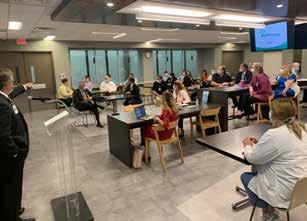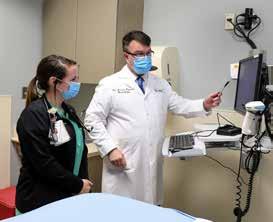
6 minute read
LEADING THROUGH A CRISIS
Leading Pandemic in a
A perspective from leadership on critical decisions made in caring for South Georgia
Advertisement
STORY BY ERIKA J. BENNETT
Ronald E. Dean, the Chief Executive Officer, and Randy Smith, Chief Nursing Officer at South Georgia Medical Center, had only been in their positions for six months when they were presented with quite the challenge as COVID-19 infected people across the world, including South Georgia. Joined by Chief Medical Officer Dr. Brian Dawson, the trio of healthcare leaders would face unprecedented times, and their leadership would be critical for an appropriate response to the pandemic’s effect on South Georgia and the ongoing healthcare delivery within the region.
As an experienced healthcare executive and having worked in hospitals and healthcare systems for over 30 years, it was obvious to Dean what needed to happen first. “It was essential that we enact our Emergency Operations Plan, a framework for acquiring and disseminating useful information, making timely decisions, and allocating resources throughout our four-hospital system. The execution of this plan would be critical to the team’s performance and necessary to combat the unknown and unprecedented healthcare delivery crisis,” said Dean.
Although hospitals and health systems conduct disaster planning on a continuous basis, the difference with COVID-19 was it was novel. Response plans had to be developed and modified to fit the situation on the fly to ensure the safety of patients, employees, physicians, and the community at large. The lack of a national stockpile of needed personal protective equipment only exacerbated the situation and made it that much more challenging. “Organizing a clinically-led response team comprised of physicians, nurses, and support services leaders was a crucial first step in having the very best minds direct our readiness and response. Out of the initial meetings, three collaboratives were formed: internal, external, and community,” shared Dean.
The internal collaborative involved clinical leaders and support services to make decisions such as clinical treatment plans, cohorting of patients, personal protective equipment acquisition and distribution, and adjustments to guidelines such as visitation. The external collaborative centered on communication and collaboration with other organizations, government officials, and state leaders to ensure access to resources and sharing of critical information. And last, the community collaborative focused on engaging the community with accurate information and education about the COVID-19 virus and the developing situation. A centerpiece of this collaboration was the implementation of a drive-thru screening station at the Smith Northview hospital campus, which would later turn into a regional testing site.
According to Smith, SGMC’s response really escalated the day the hospital was notified that a COVID-19 positive patient had been in the facility. “We immediately pulled together the clinically-led response team. It was important for us to talk with one another frequently, involve the right people and staff, and develop plans that made sense for us,” said Smith. “As the days, weeks, and months would unfold, we constantly anticipated our next steps so that we could execute and modify those plans as the situation changed.”
Physicians would “captain” the clinical ship and play the most important role in clinical decision-making. "We engaged our physician leaders from the medical staff, and in collaboration with administration and nursing, we were able to put in place a multifaceted plan to deal with various aspects and consequences of the pandemic," said Dawson.
While meetings were happening multiple times a day, seven days per week, and the situation changing by the hour, a critical component that proved successful was leadership presence. "You have to show up for the fight," said Dawson. Being physically present on the nursing units was invaluable. Because of that presence, leadership was able to rapidly address a very fluid environment.
According to Smith, "Our leaders were out there talking to the people most impacted and getting constant feedback on what was and wasn't working. We had to make sure our team members were getting psychological support and the resources to do what was needed. We involved them in the planning, bounced ideas off them, and truly worked together."
Throughout the response, SGMC’s ability to care for patients needing a higher level of care positioned the hospital as a safety net for surrounding hospitals. In the beginning, SGMC accepted patients from the region it primarily serves and then assisted by accepting patients from the Albany area. But as the number of positive results continued to rise in the state, so did the number of people needing hospitalization. All in all, SGMC was able to accept patients from 23 counties and the neighboring state of Alabama.
“We believed we were built for this fight. Operationally, we were able to open additional units, and even open patient beds at our Smith Northview Campus,” said Smith.
The decisions made early on to secure and stockpile and personal protective equipment and create additional bed capacity were vital. SGMC even revamped its transfer center, and staff began actively engaging other hospitals and letting them know SGMC was ready to help.
Communication was of utmost importance, internally and externally.
In the hospital, protocols and treatment plans were continually evolving. "We were committed to being transparent. We identified issues, concerns, and what we wanted to accomplish. Then we talked through that with many people. We added a daily COVID-19 meeting where key players looked at what was happening in the hospital, our community, and the hospitals around us. Then we'd share this information with our leaders throughout the system," said Smith.
Outside the hospital, the community needed information they could trust. “We worked closely with our public relations professionals, posting daily status reports on our website and constantly communicating with

media to ensure the most accurate information was available to those who needed it most,” said Dawson.
Looking back at the past six months, all the decisions made, all the plans executed, all of the patients cared for at SGMC, what resonated most?
"As well prepared as we were as a singular health care system, it became readily apparent that as a state and a nation, we have much work to do to better prepare for the next one," said Dean. "Our team of professionals has been remarkable. They were willing; they were capable and desired to succeed at the highest level. But, during such a crisis, it became obvious that we were dependent on others and what we realize now is that we need to conduct even more widespread multiagency planning to be better prepared for the next one.”
Smith shared, "Personally, it brought home how important the decisions are that we have to make as leaders. These decisions truly impacted every member of the community."
"It's the importance of being transparent, collaborating with community partners, and being actively helpful to those in need,” said Dawson.
Despite the pandemic, SGMC continues to grow, welcoming new physicians to the area and aligning with established practices. As the region’s most comprehensive medical center, SGMC continues to develop its capabilities and services to enrich the lives of the community it serves.
“Ultimately, patients benefit from the alignment of physician practices, the hospital, and other components of the regional healthcare system from a more robust and streamlined delivery system,” said Dawson.
Currently, the organization is undergoing a strategic master facilities planning project, which is a thorough process that will guide future development of facilities and other resources needed to provide focused care. The first step involves an extensive assessment of the healthcare needs in the community and region, followed by a precise definition of priorities for SGMC. Based on those findings, plans will be implemented over the coming months and years that will directly impact the health of the communities served by SGMC.
"This is an important step for SGMC. We have the desire, we have the ability, and we are built to be an outstanding regional destination for many specialties of care for Lowndes County, South Georgia, and the region we serve," said Dean.
Previous page: Dr. Brian Dawson, Chief Medical Officer, Ronald E. Dean, Chief Executive Officer, Randy Smith, Chief Nursing Officer. Photo by Wes Sewell Photography.










